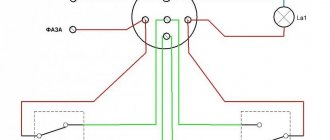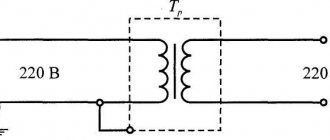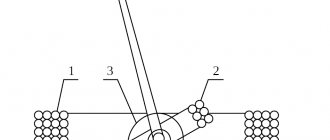Basics
A fuse is a simple and effective way to protect against dangerous levels of current:
- current flowing through a non-zero conductor resistance results in power dissipation;
- power is dissipated as heat;
- heat raises the temperature of the conductor;
- if the combination of amplitude and duration of the current is sufficient to raise the temperature above the melting point of the fuse, the fuse becomes an open circuit and the flow of current stops.
Although the basics of fuse operation are not complicated, there are subtle points to keep in mind. The rest of this article will help you understand some important details related to the behavior and use of fuses.
What it is
A fuse is a special device that performs the function of protecting a device that consumes electricity from overloads and short circuits in the network. The device consists of an insulation body, fuse-links and leads, with the help of which the inserts are attached to the electrical circuit. In order for this insert to cool and extinguish the current, quartz sand is added to some types of fuses. When a current surge occurs in a fuse, its narrowed flat insert melts first.
Important! If the insert melts completely, the circuit will be open. This is based on the fact that the device is connected to the network in series.
Heat, not current
The fuse is not triggered directly by current; rather, the current creates heat, and the heat trips the fuse. This is actually a pretty important distinction because it means that the fuse's performance is affected by the ambient temperature and the timing of the current.
The stated fuse rating only applies to a certain ambient temperature (usually, or perhaps always, 25°C) and therefore you need to take this into account when selecting a fuse if you are designing a device that will operate outdoors. say, in Antarctica or Death Valley. The following figure shows how ambient temperature affects the actual current rating relative to the specified current rating at 25°C for three fuse types.
Relative change in rated current of fuses depending on ambient temperature
Regarding the timing of the current passing through the fuse, all we know is that the effect of heat accumulates over time (momentarily touching a hot frying pan is nothing compared to picking it up and realizing how hot it is when you're on halfway between the stove and the dining table). Therefore, the current rating of a fuse is a simplification of its actual behavior. We cannot expect a fuse to respond to high amplitude transients because the short duration of high power dissipation does not increase the temperature enough to trip.
The following graph shows the timing characteristics of a group of fuses manufactured by Panasonic. The current rating is at the top and the curve represents the time it takes to open the fuse based on the amount of current flowing through the fuse.
Fuse timing characteristics
As you can see, the current amplitudes during transients must be much higher than the rated current. For example, you need 3 amps to trip a 0.5 amp fuse if the overcurrent duration is only 1 millisecond.
Gas Generating Fuses
Gas-generating fuses (also called blowing fuses) are designed for outdoor installation in 35 and 110 kV devices.
Fig.2. Cartridge of gas-generating fuse type PVT-35
Figure 2 shows a PVT-35 type fuse holder (exhaust fuse for protecting power transformers and 35 kV lines). The cartridge body 1 contains tubes 2 and 3 made of vinyl plastic, connected to each other by a steel pipe 4, as well as a fuse-link 5, attached at one end to the current-carrying rod 6, and at the other to a flexible conductor 7 with a tip 8.
Fig.3. Gas-generating fuse type PVT-35
The cartridge is installed on the base of the fuse (Fig. 3), consisting of a base 1, two support insulators 2 with heads - the top 3 and the bottom 4 with clamps for fastening the conductors. A contact knife 5 is mounted on the lower head, equipped with a spring and engaged with the tip of the cartridge. When the fuse link burns out, the contact knife is released and, reclining under the action of a spring, pulls the flexible conductor along with it. Under the action of the arc, the walls of the vinyl plastic tubes emit gas, the pressure in the cartridge increases and the arc is extinguished in the gas flow flowing from the cartridge through the lower hole, as well as through the valve of the side hole of the pipe. When the fuse is triggered, it produces a sound effect similar to a gun shot. The flexible conductor is ejected from the socket. An air gap is created between the contact blade and the end of the tube, providing insulation at the break point. The rated disconnecting current of the PVT-35 type fuse is 3.2 kA.
Rated current and operating current
It would be reasonable to assume that a fuse rated at 6 amps could be used on a circuit that could draw 5 amps continuously. However, it turns out that this is not a very good design practice. The fuse current rating is not a very precise specification, and furthermore (as discussed above) the actual breaking current depends on the ambient temperature. Therefore, to avoid "false tripping", you must have a sufficiently large gap between the current you expect to draw continuously and the rated current of your fuse. This document from Littelfuse suggests an "overestimate" of 25% (for room temperature operation); thus, a fuse rated 10 amps can only be used if the circuit's DC current will remain below 7.5 amps.
Principle of operation
Fuses operate in two modes:
The first mode assumes normal conditions. During normal operation of the network and a specific device, the temperature of the insert has a steady value. All heat generated by the device is released to the environment. In addition, contacts and other parts of the device also heat up. The heating temperature should not exceed normal values for normal operation.
The second mode is a sharp jump in current in the network. To reduce the melting time of the electrical fuse insert, the element itself is made in the form of a plate with special cutouts that reduce its cross-section in some areas of the body. More heat is concentrated in narrow areas than in wide areas.
When the current increases in the event of a short circuit, the heat generation exceeds the permissible level and heat removal is usually neglected. The fuse element melts and burns out and the current cannot increase above the permissible value.
Important! During the melting process, a so-called electric arc occurs, which in modern elements is extinguished in a limited fuse holder
You must be picky
Let's say your circuit includes a sensitive component that will definitely be damaged if more than 1 amp of current flows through it. Under normal conditions, the circuit should never draw more than 500 mA, so you include a fuse rated at 900 mA. This is high enough to prevent false triggering and low enough to ensure that 1 amp of current never flows through the sensitive component. Right?
No.
Consider the following specification for the Panasonic fuses mentioned earlier in the article: Table taken from datasheet
| Trip current / trip time (at 25°C) | Rated current x 100% / 4 hours min. |
| Rated current x 200% / 5 seconds max. | |
| Rated current x 300% / 0.2 seconds max. |
We have already discussed the fact that heat takes time to accumulate, and in this case it takes a long time: you will have to wait at least four hours for the fuse to trip when the current is equal to the rated value, and even at double the rated current the delay is up to 5 seconds . The bottom line is that a sensitive component can fry long before the fuse trips. You will have to rethink your fuse selection or (and this is probably a more practical solution in a situation like the one described above) implement a different method of dealing with high current protection.
How to connect a multimeter to a fuse and how to check it with a tester
Checking fuses is carried out from time to time in circuit breakers in control rooms of apartments or in cars. This can be done using a simple tester or multimeter.
First you need to understand the type of electrical fuse. They come in cartridge and flat versions. The first is cylindrical in shape and has been used for a long time in homes and electrical appliances. This cylinder has two metal contacts, with the help of which it is connected to the network in series. The second one is often used in cars for the last few decades. Outwardly, it looks like a wire plug, since structurally it looks like a piece of plastic with contacts sticking out of it.
After this, you should understand how the multimeter works. This is a device that measures AC and DC current, resistance and voltage. With its help, you can check the performance of any electrical appliances and their elements. This also applies to the electrical fuse.
Cylindrical glass fuse
Important! The multimeter and tester have two contacts with a positive and negative sign. To check, he passes a small amount of electricity from his battery through the circuits of the device or its element and checks how much of it is returned to the other contact.
Detailed step-by-step verification instructions are as follows:
Thus, an electrical fuse in modern technology is an important and necessary thing that can protect devices and people from the effects of high current generated as a result of a short circuit. You can check such a circuit element for functionality with a simple tester or multimeter.
Source
Don't forget the tension
Fuses are designed to have very low resistance so they do not unduly affect the circuits they protect. This low resistance means that the voltage drop across the fuse will be very small. Why do fuses have a rated voltage?
It is true that during normal operation there is a slight voltage drop across the fuses, but the rated voltage does not apply to normal operation. The voltage rating rather tells us how much voltage the fuse can withstand after it has tripped. A blown fuse represents an open circuit, and if the voltage in that open circuit is enough to cause sparking, the fuse cannot be relied upon.
It's a good practice to consider the voltage ratings if you're using tiny surface mount fuses like the one shown below (note how thin the actual fuse is). For example, the rating for a 0603 fuse could be 32 volts or even 24 volts.
SMD fuse structure
General calculation rules
In order to make the correct calculation of fuse links, it is necessary to take into account the rated voltage. This value should be such that the fuse switches off the electrical circuit. The main indicator is the minimum voltage provided for the base and fuse-link.
Another important indicator that should be taken into account in the calculations is the shutdown voltage. This parameter is the instantaneous value of the voltage that appears after the fuse or fuse link itself has tripped. As a rule, the maximum value of this voltage is taken into account.










